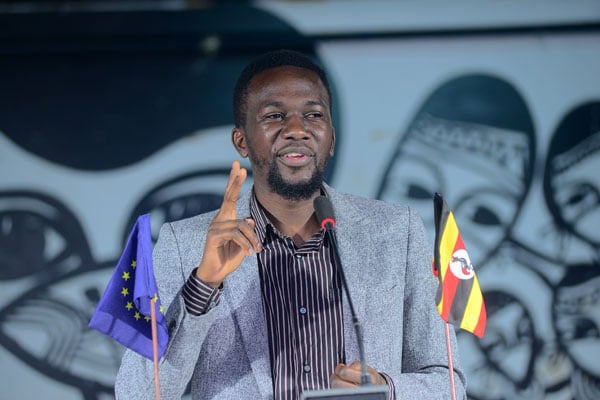Art hands refugees a coat of many colours

The proprietor of Faces Up, Emmanuel Sekitto. PHOTO/ ANDREW KAGGWA
What you need to know:
- Working in tandem with the European Union, Emmanuel Sekitto through his NGO Faces Up, launched the Youth Art Campaign as a way of integrating and forging reconciliation in refugee camps after war and calamities.
There are a lot of purposes that visual art or any form of art serves besides giving great aesthetic pleasure. A vital component of our everyday lives, art has the power to inspire, provoke, calm, entertain, and educate.
At its most profound, it transports us from the mundane to a state of reflection and introspection, allowing us to see the wider picture of human existence.
Art practitioners who have understood its power have moved to have it included in different ways of integrating and forging reconciliation after war and calamities.
This is something that Emmanuel Sekitto’s Faces Up, a non-governmental organization (NGO) providing creative arts and crafts education to underserved communities across Uganda, has moved to take advantage of. Working in tandem with the European Union (EU), it launched the Youth Art Campaign. The three refugee settlements of Bidi Bidi, Imvepi, and Rhino Camp were targeted.
Since art has the ability to transcend language barriers and connect, people from different cultures and backgrounds, it can be particularly handy in rehabilitating refugees. This is because it is believed to provide a means of expression and healing for individuals who have experienced trauma and displacement. Through art, refugees can find solace, regain a sense of identity, and build bridges with their new communities.
Bidi Bidi in Yumbe District spans 250 square kilometres, stretching southward from South Sudan’s border and spilling over into Moyo District. It is considered one of the biggest refugee settlements in the world, hosting more than 270,000 refugees. Unlike Imvepi and Rhino Camp, it had an existing art programme before the Youth Art Campaign was launched.
Stumbling block
Despite visual art being liberating, it can be an expensive venture.
The brushes, oils, and canvas are costly for people in refugee camps known to only scrape by.
This financial barrier often limits access to art materials and opportunities for self-expression, denying individuals the chance to explore their creativity and share their unique perspectives.
It is, therefore, crucial for organisations and initiatives to provide affordable or donated art supplies to less privileged communities. That is at least what Sekitto’s youth campaign sets out to do. This year, it received 682 submissions from 26 communities in the three settlements. Of these entries, 216 were from girls. Only one of them was from a child living with a disability.
“Surprisingly, all the winners came from camps without existing art programmes,” Sekitto said of the campaign aimed at finding winners from different categories such as those aged between eight and 12; 15 and 18; as well as 19 and 21.
The art programme in the refugee camp, Sekitto says, was a big moment for the community and the children too. It gave them a chance to address issues they rarely partake in—world peace, leadership, and reconciliation, among others.
Mind-blowing experience
On November 6, Alliance Francaise Kampala hosted an art exhibition with 46 paintings of children and youth that were selected from all the 682 entries. For the children, some of whom made the trip to Kampala for the exhibition, the experience was mind-blowing.
Lydia Sarah Jamila, the winner of the 19-21 age category, said she was happy to have her voice heard. She drew inspiration for her painting—Government and Leadership—from her observations.
“I enjoy art because, for communities like ours, it communicates more than writing, and it is also fun in the process,” Jamila, who stays in Imvepi, said.
Other winners were equally thrilled. Michael Feti, who prevailed in the 8-12 age category, goes to one of the schools in Rhino Settlement. Erias Simambo, his teacher, said the competition is going to generate more interest in art.
“The fact that they have even come to Kampala is almost an icing on the cake,” he said.
Richard Meta, who came top in the 13-19 age category, was the other winner. All the three winners have embarked on training with artist Alex Kwizera at his studio, whose works, most of them are murals, have been exhibited in Kampala and at public gatherings.
“I can’t wait to meet them and challenge them to make bigger works on bigger spaces,” he said, adding that he hopes to work with the youngsters on a mural at the settlement after the training.




